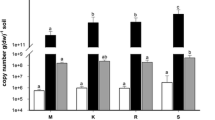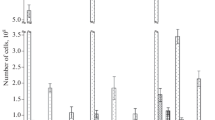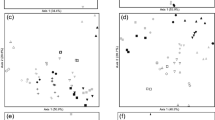Abstract
The microbial community structure along an altitude gradient was investigated in different localities, in Kalasi lake, Urumqi river and Sangong river, Xingjiang (China). The mean numbers of DAPI (4′,6-diamidino-2-phenylindole)-stained cells were lower in Kalasi lake than that in Urumqi river and Sangong river; these differences were attributed to increasing environmental harshness including lower soil organic carbon and nitrogen content, more acidic pH and lower annual temperature. In each locality, the numbers of bacteria and archaea measured with two fluorescence-labeled 16S rRNA oligonucleotide probes (EUB338 and ARCH915) were higher in a coniferous forest and lower in desert vegetation. A significant and positive relationship was found between microbial and soil organic carbon and total nitrogen along the altitudinal gradient, indicating that plant communities and soil nutrients influence the soil microbial structure. The results show that the microbial population in higher latitudinal site was fewer than lower latitudinal one, soil microorganisms were positively correlated to soil organic carbon and total nitrogen, and plant communities had an obviously impact on soil microbes.
Similar content being viewed by others
Abbreviations
- asl:
-
above sea level
- Corg :
-
soil organic carbon
- Ntot :
-
total nitrogen
- DAPI:
-
4′,6-diamidino-2-phenylindole
- FISH:
-
fluorescencein situ hybridization
References
Amann R.I., Ludwig W., Schleifer K.H.: Phylogenetic identification andin situ detection of individual microbial cells without cultivation.Microbiol.Rev. 59, 143–169 (1995).
Bogoev V.M., Kenarova A.E., Vasilev V.L., Gyosheva M.M.: Quantitative distribution of microbial biomass in the soil profile of a high-mountain grassy ecosystem.Folia Microbiol. 47, 56–60 (2002).
Broughton L.C., Gross K.L.: Patterns of diversity in plant and soil microbial communities along a productivity gradient in Michigan old-field.Oecologia 125, 420–427 (2000).
Chapin F.S. III,Korner C.H.: Patterns, causes, changes and consequences of biodiversity in arctic and alpine ecosystems, inArctic and Alpine Biodiversity: Patterns, Causes, and Ecosystem Consequences, Ecological Studies, Vol. 113 (F.S. Chapin III, C. H. Korner, Eds). Springer-Verlag, Berlin 1995.
Christensen H., Hansen M., Sørensen J.: Counting and size classification of active soil bacteria by fluorescencein situ hybridization with an rRNA oligonucleotide probe.Appl.Environ.Microbiol. 65, 1753–1761 (1999).
Couteaux M.M., Bottner P., Berg B.: Litter decomposition, climate and litter quality.Tree 10, 63–66 (1995).
Derry A.M., Staddon W.J., Kevan P.G., Trevors J.T.: Functional diversity and community structure of microorganisms in three arctic soils as determined by SCSU.Biodivers.Conserv. 8, 205–221 (1999).
Elhottová D., Szili-Kovács T., Tříska J.: Soil microbial community of abandoned sand fields.Folia Microbiol. 47, 435–440 (2002).
Head I.M., Saunders J.R., Pickup R.W.: Microbial evolution, diversity, and ecology: a decade of ribosomal RNA analysis of uncultivated microorganisms.Microb.Ecol. 35, 1–21 (1998).
Insam H., Domsch K.H.: Relationship between soil organic carbon and microbial biomass in chronosequences of reclamation sites.Microb.Ecol. 15, 177–188 (1988).
Insam H., Haselwandter K.: Metabolic quotient of the soil microflora in relation to plant succession.Oecologia 79, 174–178 (1989).
Kandeler E., Marschner P., Tscherko D., Gahoonia T.S., Nielsen N.E.: Microbial community composition and functional diversity in the rhizosphere of maize.Plant & Soil 238, 301–312 (2002).
Kaneko T., Atlas R.: Diversity of bacterial populations in the Beaufort Sea.Nature 270, 596–599 (1977).
Kao C.M., Chen S.C., Chen Y.S., Lin H.M., Chen Y.L.: Detection ofBurkholderia pseudomallei in rice fields with PCR-based technique.Folia Microbiol. 48, 521–524 (2003).
Latour X., Philippot L., Corberand T., Lemanceau P.: The establishment of an introduced community of fluorescent pseudomonads in the soil and in the rhizosphere is affected by the soil type.FEMS Microbiol.Ecol. 30, 163–170 (1996).
Llobet-Brossa E., Rosselló-Mora R., Amann R.: Microbial community composition of Wadden Sea sediments as revealed by fluorescencein situ hybridization.Appl.Environ.Microbiol. 64, 2691–2696 (1998).
Marilley L., Aragno M.: Phylogenetic diversity of bacterial communities differing in degree of proximity ofLolium perenne andTrifolium repens roots.Appl.Soil.Ecol. 13, 127–136 (1999).
Meentemeyer V., Berg B.: Regional variation in rate of mass loss ofPinus sylvestris needle litter in Swedish pine forests as influenced by climate and litter quality.Scand.J.Forest Res. 1, 167–180 (1986).
Muyzer G., Smalla K.: Application of denaturing gradient gel electrophoresis (DGGE) and temperature gradient gel electrophoresis (TGGE) in microbial ecology.Antonie van Leeuwenhoek 73, 127–141 (1998).
Ohtonen R., Vare H.: Vegetation composition determines microbial activities in a boreal forest soil.Microb.Ecol. 36, 328–335 (1998).
Staddon W.J., Trevors J.T., Duchesne L.C., Colombo C.A.: Soil microbial diversity and community structure across a climatic gradient in western Canada.Biodivers.Conserv. 7, 1081–1092 (1998).
Stephan A., Meyer A.H., Schmid B.: Plant diversity affects culturable soil bacteria in experimental grassland communities.J.Ecol. 88, 988–998 (2000).
Swift M.J., Andren O., Brussaard L., Briones M., Couteaus M.M., Ekschmitt K., Kjoller A., Loiseau P., Smith P.: Global change, soil biodiversity, and nitrogen cycling in terrestrial ecosystems: three case studies.Global Change Biol. 4, 729–744 (1998).
Tiedje J.M., Asuming-Brempong S., Nüsslein K., Marsh T.L., Flynn S.J.: Opening the black box of soil microbial diversity.Appl. Soil Ecol. 13, 109–122 (1999).
Veselova M., Kholmeckaya M., Klein S., Voronina E., Lipasova V., Metlitskaya A., Mayatskaya A., Lobanok E., Khmel I., Chernin L.: Production ofN-acylhomoserine lactone signal molecules by Gram-negative soil-borne and plant-associated bacteria.Folia Microbiol. 48, 794–798 (2003).
Wahlström G., Danilov R.A.: Phytoplankton successions under ice cover in four lakes located in North-Eastern Sweden: effects of limingFolia Microbiol. 48, 379–384 (2003).
Wardle D.A., Verhoef H.A., Clarholm M.: Trophic relationships in the soil microfood-web: predicting the responses to a changing global environment.Global Change Biol. 4, 713–727 (1998).
Whittaker R.H.:Communities and Ecosystems. MacMillan Publisher, New York 1975.
Zak D.R., Grigal D.R., Gleeson S., Tilman D.: Carbon and nitrogen cycling during old-field succession: constraints on plant and microbial biomass.Biogeochemistry 11, 111–129 (1990).
Zak D.R., Tilman D., Parmenter R.R., Rice C.W., Fisher F.M., Vose J., Milchunas D., Martin C.W.: Plant production and soil microorganisms in late-successional ecosystems: a continental scale study.Ecology 75, 2333–2347 (1994).
Zhang X.J., Yao T.D., Ma X.J., Wang N.L.: Microorganisms in a high altitude glacier ice in Tibet.Folia Microbiol. 47, 241–246 (2002).
Author information
Authors and Affiliations
Corresponding author
Additional information
This work was funded byKnowledge-Innovation Projects of Chinese Academy of Sciences (KZCX1-10-03, KZCX1-10-07),The Key Laboratory of Ice Core and Cold Regions Environments, Chinese Academy of Sciences (210 506), and theNatural Science Foundation of China (901 02003),
Rights and permissions
About this article
Cite this article
Ma, X., Chen, T., Zhang, G. et al. Microbial community structure along an altitude gradient in three different localities. Folia Microbiol 49, 105–111 (2004). https://doi.org/10.1007/BF02931382
Received:
Revised:
Issue Date:
DOI: https://doi.org/10.1007/BF02931382




